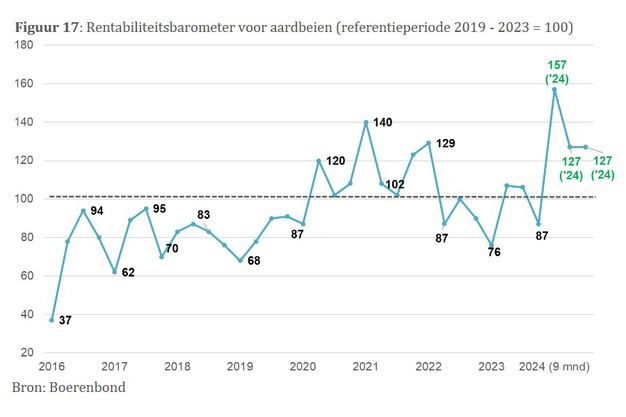Greenhouse vegetable growers realized an average turnover increase of about 6 percent in the first 8 months of 2024. Price increases in cucumber and vine tomatoes in particular contributed to this, stemming from lower production. In general, industry organization Boerenbond pointed to 'very difficult weather conditions', which mainly affected outdoor crops.
In 2024, the estimated added value of the Flemish agriculture and horticulture sector is €1.566 billion. Although there are large differences between sectors, this is some 4% higher than in 2023.
For greenhouse vegetables, a turnover increase of some 6.0% was recorded, driven by price increases for cucumbers and vine tomatoes. For strawberries, the turnover figure increased by 18%. In the first eight months of 2024, marketed quantities of strawberries increased by 8.7% compared to 2023. Strawberry prices were 8.2% higher in the same period compared to 2023.
Global production of greenhouse vegetables decreased by 3.4% in the first 8 months of 2024 compared to 2023. This decline was mainly due to production declines for just about all greenhouse vegetables, with the exception of vine tomatoes. The most notable production decline was recorded for head lettuce (-20.0%) and sweet pepper (-13.0%). Outdoor lettuce production fell 11%.
Prices of greenhouse vegetables rose by an average of 9.6%, mainly due to price increases for cucumbers (+52%), aubergines (+9%), vine tomatoes (+2%), and peppers (+1%).
Rise in costs
Energy prices, which account for some 13.2% of total direct costs in 2024, saw an average increase of 8.0% in the first eight months of 2024. However, there are varying evolutions depending on the energy carrier. Diesel and heating oil prices recorded a slight decrease (- 2% on average) while gas prices rose by some 20.0%. On the other hand, electricity prices fell by 15%. Importantly, farmers and horticulturists continue to invest in their own (green) energy generation via CHPs, solar panels, (pocket) digesters, etc.
Wages paid to agricultural and horticultural employees represent 8.2% of direct costs in 2024. On 1 January 2024, wages were indexed by 1.83% and this was for both regular and seasonal employees. In the agriculture and horticulture sector, the main employment takes place in the 3rd quarter of the year.
Admittedly, the weight of the wage cost paid differs enormously between the subsectors. For example, horticulture in particular relies on externally paid labor where, depending on the crop, the wage cost can take up to 30% of the total cost. Paid labor is less common in animal husbandry. There, cattle feed costs weigh most heavily.
Profitability
Profitability for greenhouse vegetables rebounded after a poor first quarter. In the first quarter of 2024, the profitability index for greenhouse vegetables fell remarkably sharply because of sharp price decreases for all products in the basket, i.e. greenhouse lettuce (-39%), cucumbers (-35%), tomatoes (-32%) and peppers (-19%). The explanation is the significantly higher supply of these vegetables from southern countries, including Morocco. Tomato supply was also higher in Belgium because of more favorable energy prices.
In Q2 2024, prices of greenhouse lettuce, sweet pepper, and cucumber rebounded significantly, boosting the profitability index sharply from the 5-year average 2019-2023.
There was then a slight decline in the 3rd quarter due to a price drop in August 2024 for tomatoes, greenhouse lettuce, and capsicum. It is important to note that the 5-year index was impacted by the major energy crisis in 2022.

The profitability barometer for strawberries is highly volatile. The increase in the profitability index in 2024 stems from a combination of increased prices and increased production, which was mainly in the 1st quarter of 2024. The profitability index in 2024 is quite above the average of the past 5 years.











